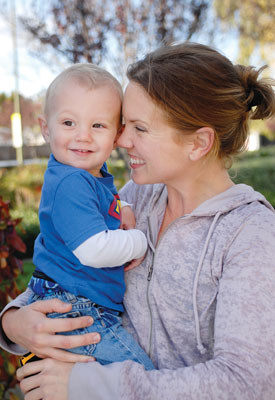A summer day in July escalated from panicky to awful to the
worst day of Theresa Bergholz’s life. It was the day she had to
rush her then 10-and-a-half-month-old son Benjamin to the emergency
room. He was diagnosed with Type 1 juvenile diabetes.
A summer day in July escalated from panicky to awful to the worst day of Theresa Bergholz’s life. It was the day she had to rush her then 10-and-a-half-month-old son Benjamin to the emergency room. He was diagnosed with Type 1 juvenile diabetes.
Just hours earlier his pediatrician misdiagnosed his diabetes as asthma. Benjamin’s heavy breathing triggered Bergholz to take her first-born child to the doctor.
“I was skeptical. And I was disappointed because asthma is horrible,” said Bergholz, who recently moved from Morgan Hill to San Jose.
But then he vomited, and on the way to the ER, he crashed.
“He kind of just wilted in my arms. Up until that point he was perfectly healthy. He was ahead of the curve even. In the 90th percentile of height and weight,” she said. Bergholz theorized it might be the flu. “His cousin had just gotten over (the flu) … I never had a sick baby before, maybe that’s what (the flu) looked like, but he didn’t get any better.”
Benjamin, thankfully, is OK and adjusting to what will be a lifetime of monitoring his blood sugar levels. Type 1 diabetes is a chronic, auto-immune disease affecting every organ system because the body does not produce enough insulin-producing cells causing the pancreas to stop working. It is most often diagnosed during childhood and, according to Dr. Bruce Buckingham – Benjamin’s doctor and a professor of endocrinology at Stanford University – the symptoms of Type 1 are often overlooked.
“If we can make the community aware when they first see the signs: increased appetite, thirst and urination,” he said. Also, diabetics will lose weight despite being constantly hungry and thirsty, become fatigued easily and if not attended to Type 1 diabetic’s will vomit without having diarrhea, and develop deep and rapid breathing.
“They might not have any severe illness. Benjamin was suffering from acidosis. He was really sick, in the ICU for several days. If it was picked up on earlier, it would have been a much easier treatment and diagnosis,” Dr. Buckingham said. November marked National Diabetes Awareness Month in the United States.
In the U.S. about one in 300 to 400 children have Type 1 diabetes; and it’s Bergholz’s goal and the Juvenile Diabetes Research Foundation’s mission to inform parents of the symptoms; it’s not uncommon that Type 1 is confused with the flu or even asthma, like in Benjamin’s case. A simple urine test or blood sample, which is more definitive, can diagnosis Type 1, Dr. Buckingham says.
“Our goal is to really make this something people are thinking about a little more. If your child is initially dry at night and then gets up at night frequently … About 40 percent of the kids get really sick and have to go to the Intensive Care Unit. If someone recognizes it earlier than you don’t come in (to the hospital) sick at all. A lot of times it can treated as an outpatient,” Dr. Buckingham said.
While there’s no cure, researchers and other endocrinologists are working to find ways to reproduce the needed islet cells, develop an artificial pancreas and advance stem cell and embryonic stem cell research.
While the professionals and the Juvenile Diabetes Research Foundation work to that end, Bergholz is adamant about ensuring other moms and dads are aware of the signs. So much so, that she even followed a woman into the bathroom after overhearing her complain to her young son about how often he was urinating.
“If I could spare one person the trauma of going through this, if anyone has any concerns at all they should demand the test and not let any doctor blow them off. Always ask questions,” Bergholz said. She credits Dr. Buckingham with saving Benjamin’s life.
It was the unknown that was the scariest for her, though now that he is diagnosed the family can move forward and get used to the daily regimen of finger pricks to check his blood glucose levels and maintaining a baby-sized insulin pump.
Since Benjamin’s body isn’t producing the insulin-producing islet cells because he doesn’t have a functioning pancreas, insulin must be released into his system throughout the day to keep his blood sugar stable.
When a Type 1 diabetic’s “number” starts to go too low – and it can happen in mere moments – attention must be paid to the details, such as if a child suddenly becomes quieter than usual. Glucose checks must happen every few hours, usually when a child wants to eat, before and after exercise and during sleep.
If a Type 1 diabetic’s blood sugar level falls too low they can experience hypoglycemia: sweating, hunger, mood changes, confusion, blurred vision, heart palpitations or seizures. Any of these signs should never be ignored, Dr. Buckingham said, and they can lead to a tragic ending if they are.
“It was in the back of my mind. Somewhere I heard about the signs, but I didn’t connect the dots. He seemed so normal, until the day it all came to a head. It was horrifying,” Bergholz said.
Benjamin, now 15-months-old, is doing well, and Bergholz is learning the ins and outs of not only how to care for a toddler but a child with Type 1 diabetes.
“I have my baby back. He’s wild and happy and smart and developing exactly how he should. Test your child, the amount of glucose in the blood, it could save them a similar, almost tragic, experience,” Bergholz said.
For more information on juvenile diabetes, the symptoms and local support groups, go to www.facebook.com/myJDRF.








